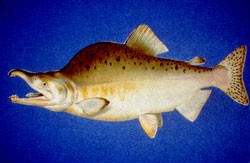|
| 질의: Silver fish | 결과: 71번째/204 | |
Pink Salmon (Oncorhynchus gorbuscha) - Wiki
| 제목: | Pink Salmon (Oncorhynchus gorbuscha) - Wiki
| |

| 해상도: 250x163
파일크기: 13936 Bytes
등록시간: 2007:12:17 11:16:48
|
Pink salmon
From Wikipedia, the free encyclopedia
Order: Salmoniformes
Family: Salmonidae
[Photo] Male Pink Salmon (Oncorhynchus gorbuscha) at spawning time. URL: http://en.wikipedia.org/wiki/Image:Pink_salmon.jpg
Pink salmon or humpback salmon, Oncorhynchus gorbuscha, (from a Russian name for this species gorbuscha--горбуша) is a species of anadromous fish in the salmon family. It is the smallest and most abundant of the Pacific salmon.
Appearance
In the ocean, pink salmon are bright silver fish. After returning to their spawning stream, their coloring changes to pale grey on the butt with yellowish white belly (although some turn an overall dull green color). As with all salmon, in addition to the dorsal fin they also have an adipose fin. The fish is characterized by a white mouth with black gums, no teeth on the tongue, large oval-shaped black spots on the back and v-shaped tail, and an anal fin with 13-17 soft rays. During their spawning migration, males develop a pronounced humped back, hence their nickname "humpies". Pink salmon average 4.8 pounds (2.2 kg) in weight. The maximum recorded size was 30 inches (76 cm) and 15 pounds (6.8 kg).
Reproduction
Pink salmon in their native range have a strict two year life cycle, thus odd- and even-year populations do not interbreed. Adult pink salmon enter spawning streams from the ocean, usually returning to the water course, or race, where they originated. Spawning occurs between late June and mid-October. Pink salmon spawn in coastal streams and some longer rivers, and may spawn in the intertidal zone or at the mouth of streams if hyporheic freshwater is available. Using her tail, the female digs a trough-shaped nest, called a redd, in the gravel of the stream bed, wherein she deposits her eggs. As she expresses the eggs, she is approached by one or more males who fertilize them as they fall into the redd. Subsequently, the female covers the newly-deposited zygotes, again with thrusts of her tail against the gravel at the top of the redd. The female lays from 1000 to 2000 eggs in several clutches within the redd, often fertilized by different males. Females guard their redds until death, which comes within days of spawning. In dense populations, a major source of mortality for embryos is superposition of redds by later-spawning fish. The eggs hatch from December to February, depending on water temperature, and the juveniles emerge from the gravel during March and April and quickly migrate downstream to estuaries at about one-quarter gram. The fish achieve sexual maturity in their second year of life. They return to freshwater in the summer or autumn as two year old adults. Pink and chum salmon sometimes interbreed in nature to form the hybrid known as the miko salmon; the hybrids are reproductively sterile.
Habitat
Pink salmon are coldwater fish with a preferred temperature range of 5.6 to 14.6°C, an optimal temperature of 10.1°C, and an upper incipient lethal temperature of 25.8°C. The species is native to Pacific and Arctic coastal waters from the Sacramento River in northern California to the Mackenzie River in Canada; and in the west from the Lena River in Siberia to Korea. Populations in Asia occur as far south as Hondo Island in Japan. Pink salmon were introduced into the Great Lakes; this is the only location where they have been successfully introduced into an entirely fresh water environment. In the Great Lakes, they are most common in Lake Superior but are rare in Lake Michigan.
Commerce
The commercial harvest of pink salmon is a mainstay of fisheries of both the eastern and western North Pacific; over 100 million have been taken in recent annual harvests in Alaska alone. More than 20 million harvested pink salmon are produced by fishery-enhancement hatcheries, particularly in the northern Gulf of Alaska. Pink salmon are not grown in significant numbers in fish farms. The fish are often canned, smoked or salted. Pink salmon roe is also produced commercially for caviar, a particularly valuable product in Asia.
Beginning in the late nineteenth century, fish traps were used to supply fish for commercial canning and salting. The industry expanded steadily until 1920. During the 1940s and 1950s, Pink Salmon populations declined drastically. Fish traps were prohibited in Alaska in 1959. Now most pink salmon are taken with purse seines, drift nets or gillnets. Populations and harvests increased rapidly after the mid 1970s and have been at record high numbers since the 1980s.
"Salmon pink" is a color named for the typically pink color of this fish's flesh.
http://en.wikipedia.org/wiki/Pink_salmon
| The text in this page is based on the copyrighted Wikipedia article shown in above URL. It is used under the GNU Free Documentation License. You may redistribute it, verbatim or modified, providing that you comply with the terms of the GFDL. |
|
댓글 |
|---|
| | 손님 |
|
| uuuuuuuuuuuuuuuuuuuuuuuuuummmmmmmmmmmmmmmmmmmmmmmmmm |
| | 손님 |
|
| wwwwwwwwhhhhhhhhhhhaaaaaaaaaaaaaaatttttttttttttt |
^o^
동물그림창고 똑똑전화 누리집
^o^
|
|
|